Human Resource Management - Sample Assignment
VerifiedAdded on 2021/05/27
|14
|3180
|23
AI Summary
Contribute Materials
Your contribution can guide someone’s learning journey. Share your
documents today.
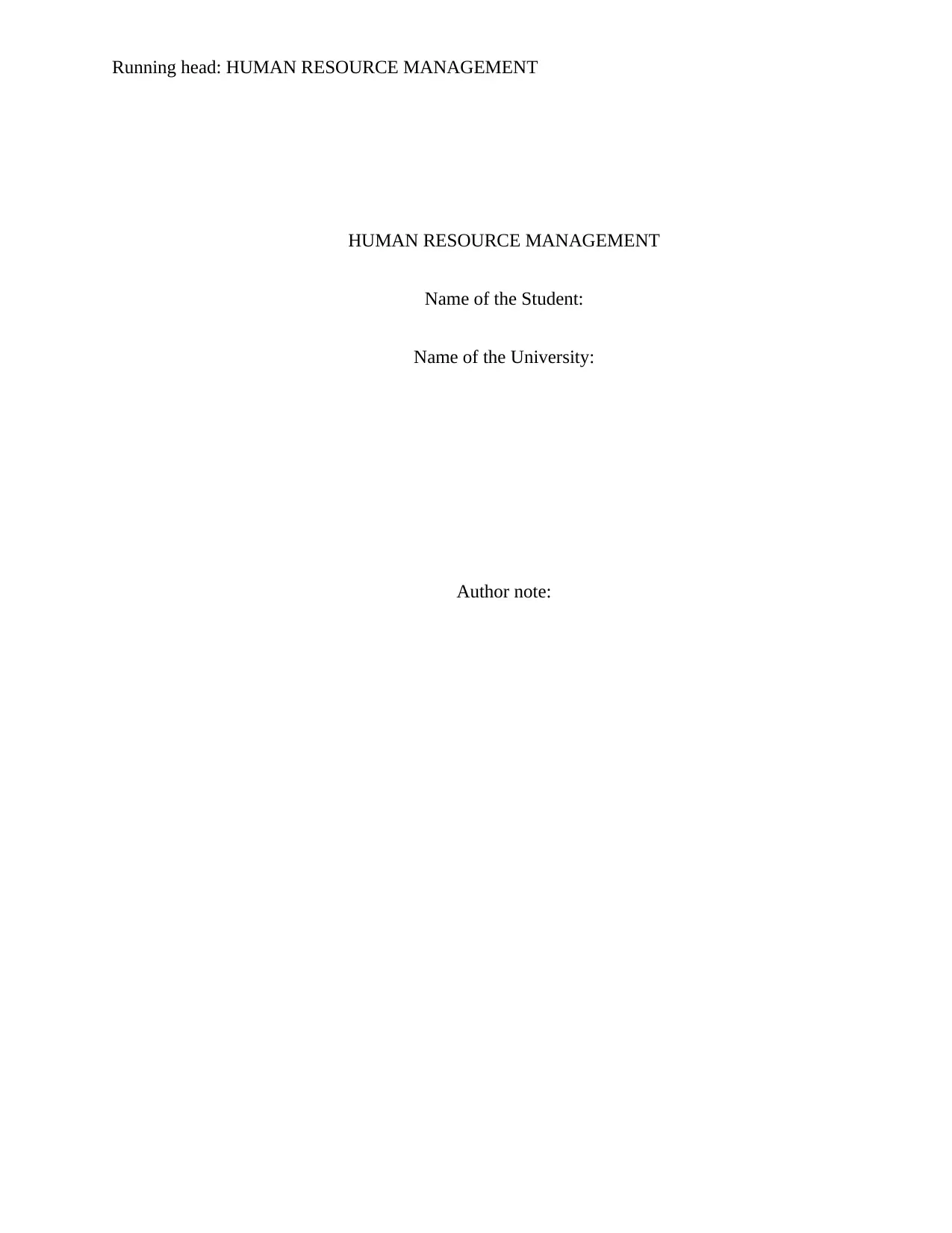
Running head: HUMAN RESOURCE MANAGEMENT
HUMAN RESOURCE MANAGEMENT
Name of the Student:
Name of the University:
Author note:
HUMAN RESOURCE MANAGEMENT
Name of the Student:
Name of the University:
Author note:
Secure Best Marks with AI Grader
Need help grading? Try our AI Grader for instant feedback on your assignments.
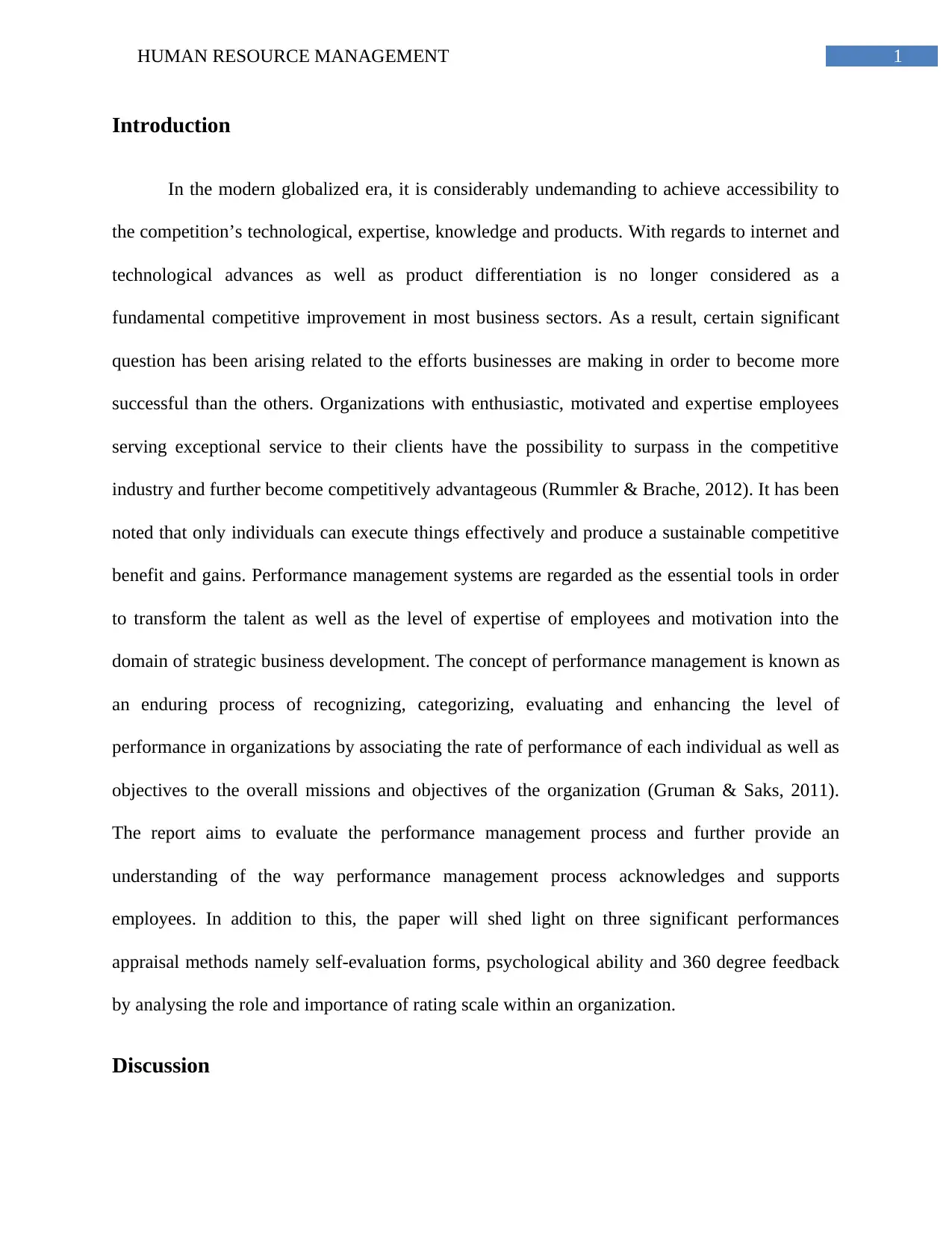
1HUMAN RESOURCE MANAGEMENT
Introduction
In the modern globalized era, it is considerably undemanding to achieve accessibility to
the competition’s technological, expertise, knowledge and products. With regards to internet and
technological advances as well as product differentiation is no longer considered as a
fundamental competitive improvement in most business sectors. As a result, certain significant
question has been arising related to the efforts businesses are making in order to become more
successful than the others. Organizations with enthusiastic, motivated and expertise employees
serving exceptional service to their clients have the possibility to surpass in the competitive
industry and further become competitively advantageous (Rummler & Brache, 2012). It has been
noted that only individuals can execute things effectively and produce a sustainable competitive
benefit and gains. Performance management systems are regarded as the essential tools in order
to transform the talent as well as the level of expertise of employees and motivation into the
domain of strategic business development. The concept of performance management is known as
an enduring process of recognizing, categorizing, evaluating and enhancing the level of
performance in organizations by associating the rate of performance of each individual as well as
objectives to the overall missions and objectives of the organization (Gruman & Saks, 2011).
The report aims to evaluate the performance management process and further provide an
understanding of the way performance management process acknowledges and supports
employees. In addition to this, the paper will shed light on three significant performances
appraisal methods namely self-evaluation forms, psychological ability and 360 degree feedback
by analysing the role and importance of rating scale within an organization.
Discussion
Introduction
In the modern globalized era, it is considerably undemanding to achieve accessibility to
the competition’s technological, expertise, knowledge and products. With regards to internet and
technological advances as well as product differentiation is no longer considered as a
fundamental competitive improvement in most business sectors. As a result, certain significant
question has been arising related to the efforts businesses are making in order to become more
successful than the others. Organizations with enthusiastic, motivated and expertise employees
serving exceptional service to their clients have the possibility to surpass in the competitive
industry and further become competitively advantageous (Rummler & Brache, 2012). It has been
noted that only individuals can execute things effectively and produce a sustainable competitive
benefit and gains. Performance management systems are regarded as the essential tools in order
to transform the talent as well as the level of expertise of employees and motivation into the
domain of strategic business development. The concept of performance management is known as
an enduring process of recognizing, categorizing, evaluating and enhancing the level of
performance in organizations by associating the rate of performance of each individual as well as
objectives to the overall missions and objectives of the organization (Gruman & Saks, 2011).
The report aims to evaluate the performance management process and further provide an
understanding of the way performance management process acknowledges and supports
employees. In addition to this, the paper will shed light on three significant performances
appraisal methods namely self-evaluation forms, psychological ability and 360 degree feedback
by analysing the role and importance of rating scale within an organization.
Discussion
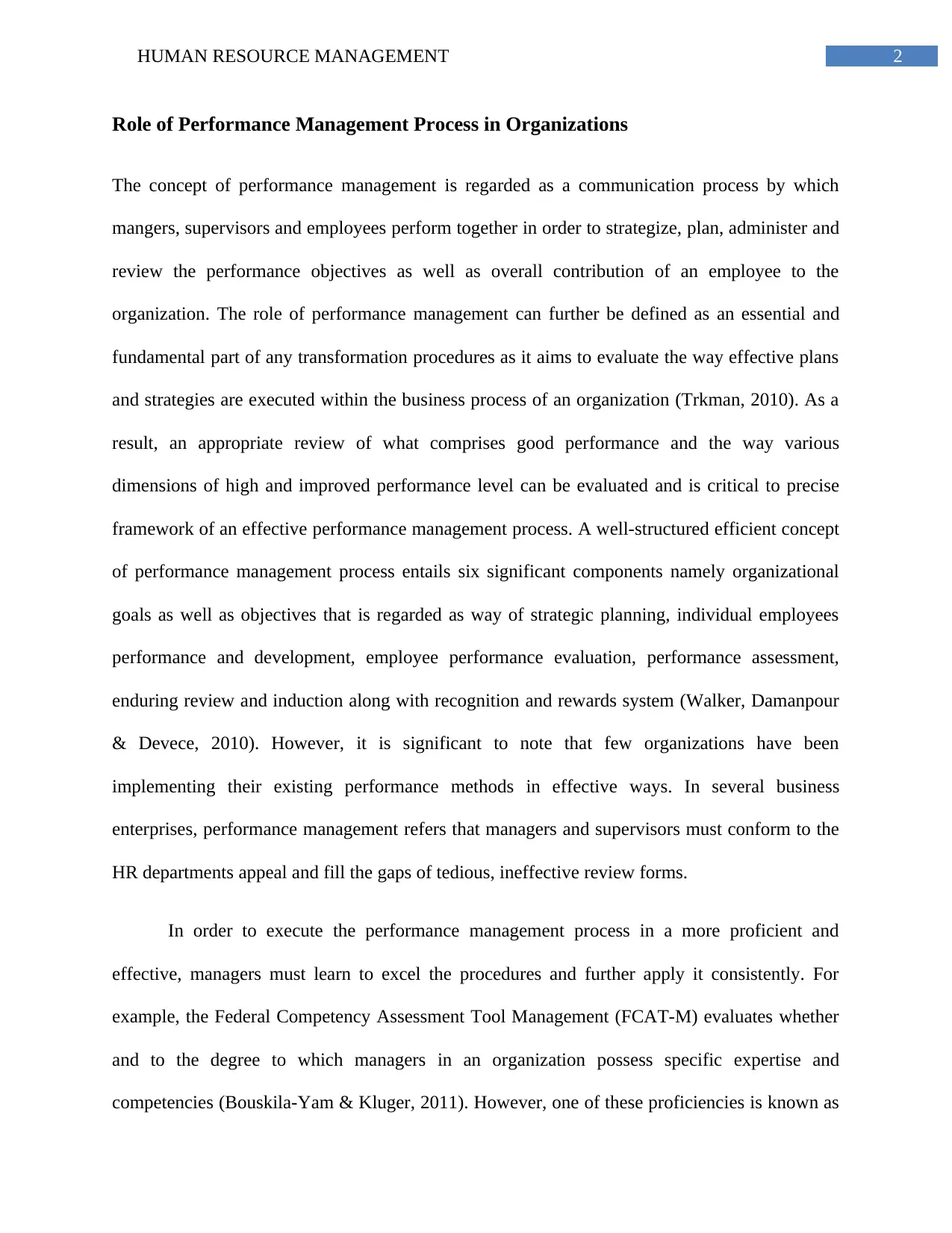
2HUMAN RESOURCE MANAGEMENT
Role of Performance Management Process in Organizations
The concept of performance management is regarded as a communication process by which
mangers, supervisors and employees perform together in order to strategize, plan, administer and
review the performance objectives as well as overall contribution of an employee to the
organization. The role of performance management can further be defined as an essential and
fundamental part of any transformation procedures as it aims to evaluate the way effective plans
and strategies are executed within the business process of an organization (Trkman, 2010). As a
result, an appropriate review of what comprises good performance and the way various
dimensions of high and improved performance level can be evaluated and is critical to precise
framework of an effective performance management process. A well-structured efficient concept
of performance management process entails six significant components namely organizational
goals as well as objectives that is regarded as way of strategic planning, individual employees
performance and development, employee performance evaluation, performance assessment,
enduring review and induction along with recognition and rewards system (Walker, Damanpour
& Devece, 2010). However, it is significant to note that few organizations have been
implementing their existing performance methods in effective ways. In several business
enterprises, performance management refers that managers and supervisors must conform to the
HR departments appeal and fill the gaps of tedious, ineffective review forms.
In order to execute the performance management process in a more proficient and
effective, managers must learn to excel the procedures and further apply it consistently. For
example, the Federal Competency Assessment Tool Management (FCAT-M) evaluates whether
and to the degree to which managers in an organization possess specific expertise and
competencies (Bouskila-Yam & Kluger, 2011). However, one of these proficiencies is known as
Role of Performance Management Process in Organizations
The concept of performance management is regarded as a communication process by which
mangers, supervisors and employees perform together in order to strategize, plan, administer and
review the performance objectives as well as overall contribution of an employee to the
organization. The role of performance management can further be defined as an essential and
fundamental part of any transformation procedures as it aims to evaluate the way effective plans
and strategies are executed within the business process of an organization (Trkman, 2010). As a
result, an appropriate review of what comprises good performance and the way various
dimensions of high and improved performance level can be evaluated and is critical to precise
framework of an effective performance management process. A well-structured efficient concept
of performance management process entails six significant components namely organizational
goals as well as objectives that is regarded as way of strategic planning, individual employees
performance and development, employee performance evaluation, performance assessment,
enduring review and induction along with recognition and rewards system (Walker, Damanpour
& Devece, 2010). However, it is significant to note that few organizations have been
implementing their existing performance methods in effective ways. In several business
enterprises, performance management refers that managers and supervisors must conform to the
HR departments appeal and fill the gaps of tedious, ineffective review forms.
In order to execute the performance management process in a more proficient and
effective, managers must learn to excel the procedures and further apply it consistently. For
example, the Federal Competency Assessment Tool Management (FCAT-M) evaluates whether
and to the degree to which managers in an organization possess specific expertise and
competencies (Bouskila-Yam & Kluger, 2011). However, one of these proficiencies is known as
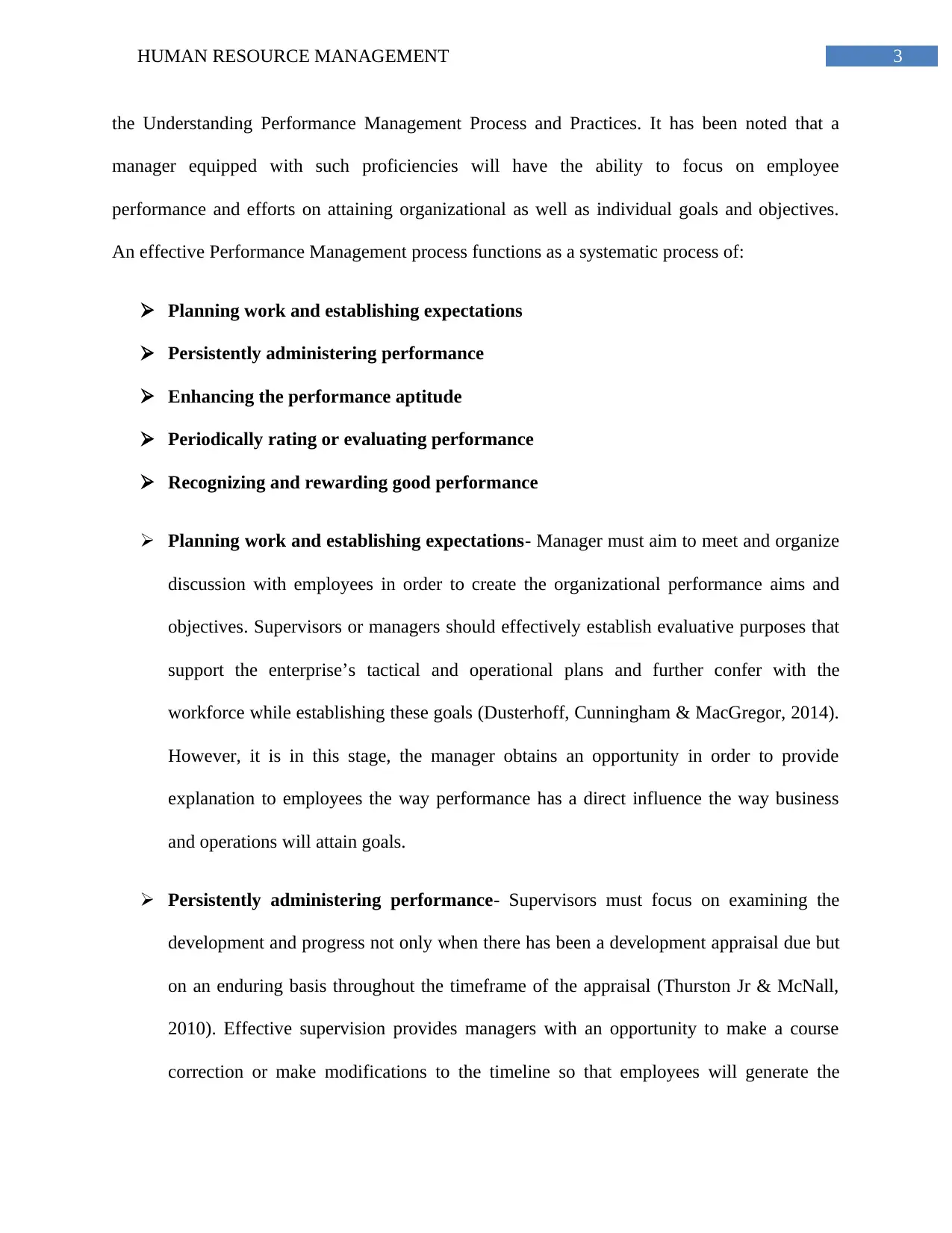
3HUMAN RESOURCE MANAGEMENT
the Understanding Performance Management Process and Practices. It has been noted that a
manager equipped with such proficiencies will have the ability to focus on employee
performance and efforts on attaining organizational as well as individual goals and objectives.
An effective Performance Management process functions as a systematic process of:
Planning work and establishing expectations
Persistently administering performance
Enhancing the performance aptitude
Periodically rating or evaluating performance
Recognizing and rewarding good performance
Planning work and establishing expectations- Manager must aim to meet and organize
discussion with employees in order to create the organizational performance aims and
objectives. Supervisors or managers should effectively establish evaluative purposes that
support the enterprise’s tactical and operational plans and further confer with the
workforce while establishing these goals (Dusterhoff, Cunningham & MacGregor, 2014).
However, it is in this stage, the manager obtains an opportunity in order to provide
explanation to employees the way performance has a direct influence the way business
and operations will attain goals.
Persistently administering performance- Supervisors must focus on examining the
development and progress not only when there has been a development appraisal due but
on an enduring basis throughout the timeframe of the appraisal (Thurston Jr & McNall,
2010). Effective supervision provides managers with an opportunity to make a course
correction or make modifications to the timeline so that employees will generate the
the Understanding Performance Management Process and Practices. It has been noted that a
manager equipped with such proficiencies will have the ability to focus on employee
performance and efforts on attaining organizational as well as individual goals and objectives.
An effective Performance Management process functions as a systematic process of:
Planning work and establishing expectations
Persistently administering performance
Enhancing the performance aptitude
Periodically rating or evaluating performance
Recognizing and rewarding good performance
Planning work and establishing expectations- Manager must aim to meet and organize
discussion with employees in order to create the organizational performance aims and
objectives. Supervisors or managers should effectively establish evaluative purposes that
support the enterprise’s tactical and operational plans and further confer with the
workforce while establishing these goals (Dusterhoff, Cunningham & MacGregor, 2014).
However, it is in this stage, the manager obtains an opportunity in order to provide
explanation to employees the way performance has a direct influence the way business
and operations will attain goals.
Persistently administering performance- Supervisors must focus on examining the
development and progress not only when there has been a development appraisal due but
on an enduring basis throughout the timeframe of the appraisal (Thurston Jr & McNall,
2010). Effective supervision provides managers with an opportunity to make a course
correction or make modifications to the timeline so that employees will generate the
Secure Best Marks with AI Grader
Need help grading? Try our AI Grader for instant feedback on your assignments.
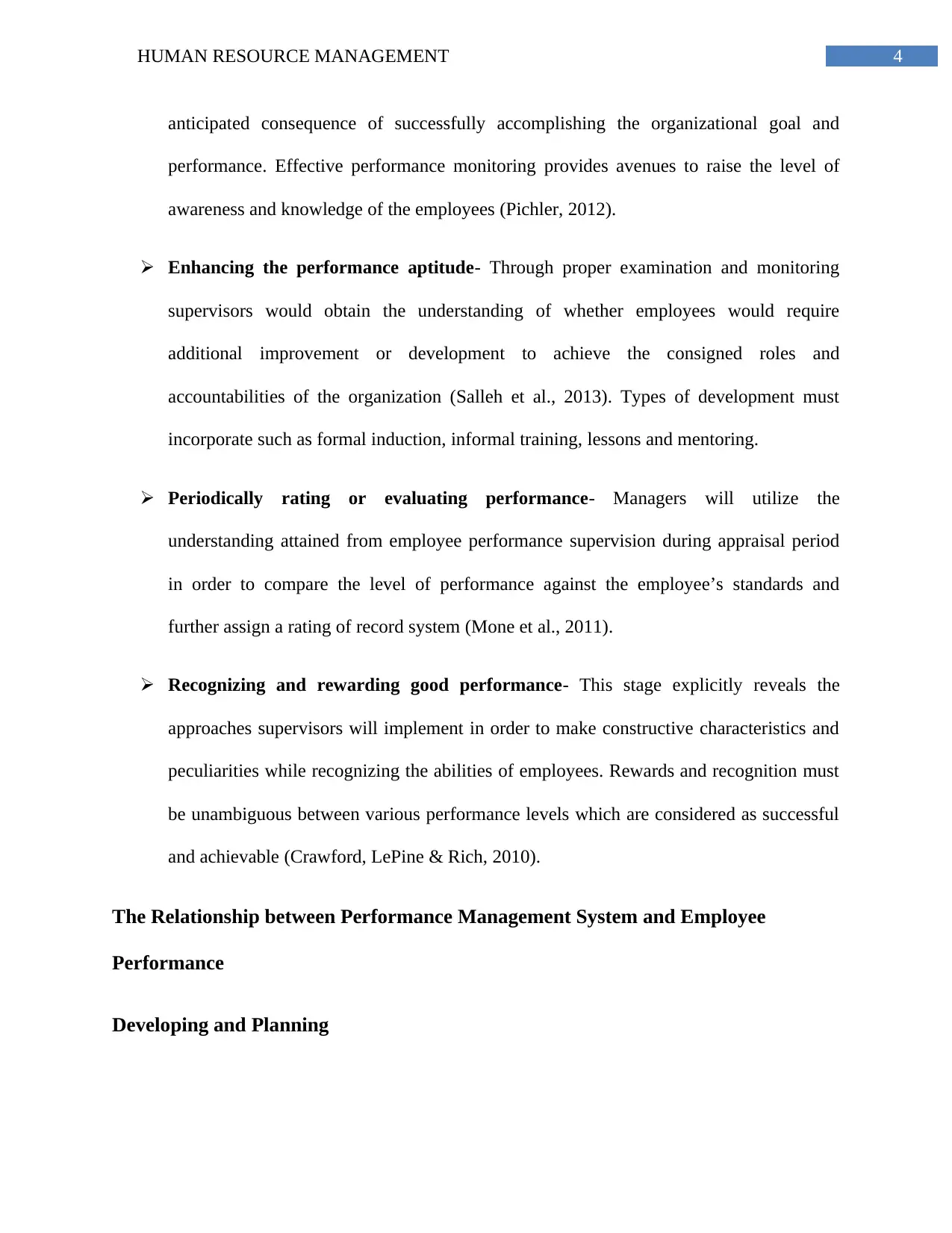
4HUMAN RESOURCE MANAGEMENT
anticipated consequence of successfully accomplishing the organizational goal and
performance. Effective performance monitoring provides avenues to raise the level of
awareness and knowledge of the employees (Pichler, 2012).
Enhancing the performance aptitude- Through proper examination and monitoring
supervisors would obtain the understanding of whether employees would require
additional improvement or development to achieve the consigned roles and
accountabilities of the organization (Salleh et al., 2013). Types of development must
incorporate such as formal induction, informal training, lessons and mentoring.
Periodically rating or evaluating performance- Managers will utilize the
understanding attained from employee performance supervision during appraisal period
in order to compare the level of performance against the employee’s standards and
further assign a rating of record system (Mone et al., 2011).
Recognizing and rewarding good performance- This stage explicitly reveals the
approaches supervisors will implement in order to make constructive characteristics and
peculiarities while recognizing the abilities of employees. Rewards and recognition must
be unambiguous between various performance levels which are considered as successful
and achievable (Crawford, LePine & Rich, 2010).
The Relationship between Performance Management System and Employee
Performance
Developing and Planning
anticipated consequence of successfully accomplishing the organizational goal and
performance. Effective performance monitoring provides avenues to raise the level of
awareness and knowledge of the employees (Pichler, 2012).
Enhancing the performance aptitude- Through proper examination and monitoring
supervisors would obtain the understanding of whether employees would require
additional improvement or development to achieve the consigned roles and
accountabilities of the organization (Salleh et al., 2013). Types of development must
incorporate such as formal induction, informal training, lessons and mentoring.
Periodically rating or evaluating performance- Managers will utilize the
understanding attained from employee performance supervision during appraisal period
in order to compare the level of performance against the employee’s standards and
further assign a rating of record system (Mone et al., 2011).
Recognizing and rewarding good performance- This stage explicitly reveals the
approaches supervisors will implement in order to make constructive characteristics and
peculiarities while recognizing the abilities of employees. Rewards and recognition must
be unambiguous between various performance levels which are considered as successful
and achievable (Crawford, LePine & Rich, 2010).
The Relationship between Performance Management System and Employee
Performance
Developing and Planning
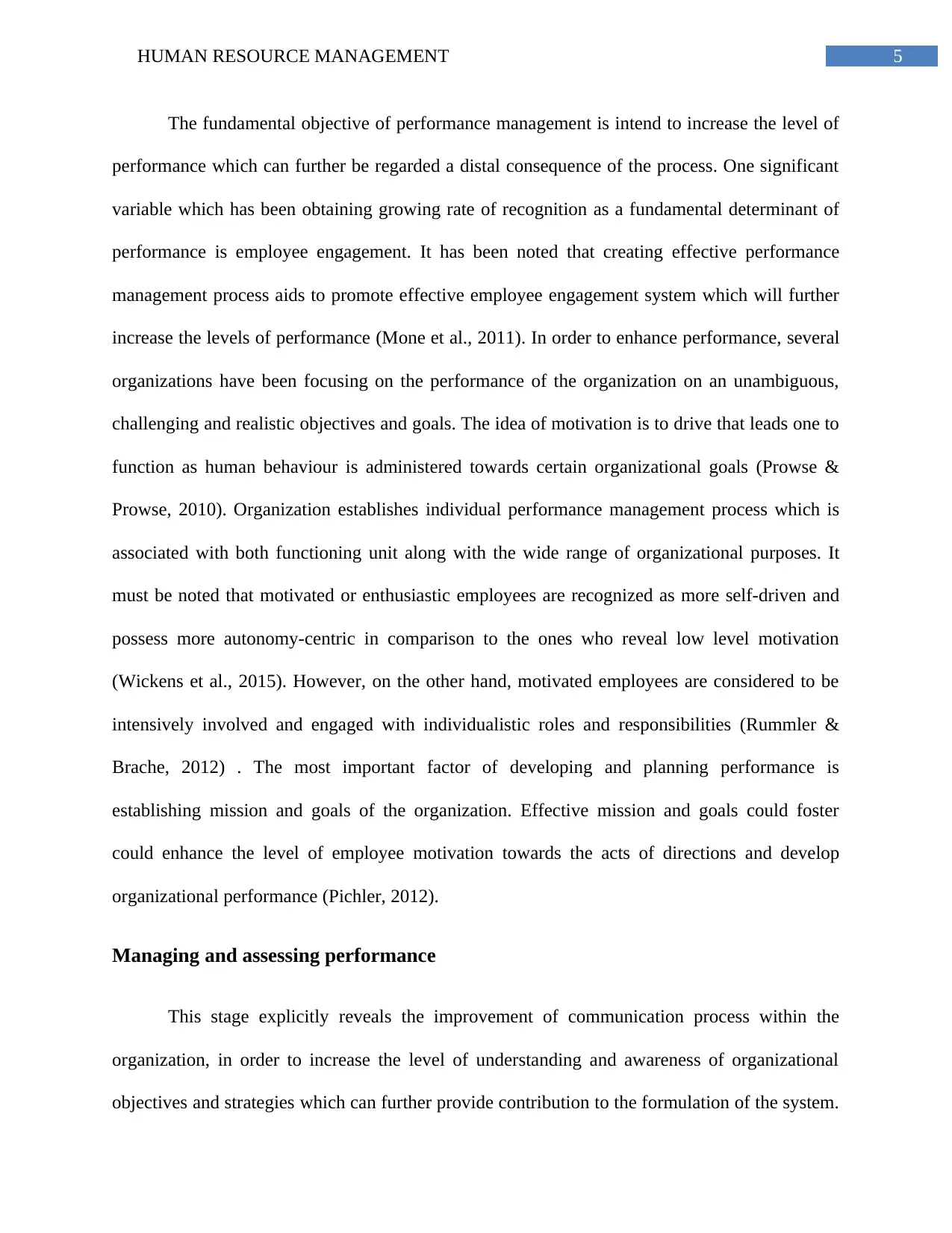
5HUMAN RESOURCE MANAGEMENT
The fundamental objective of performance management is intend to increase the level of
performance which can further be regarded a distal consequence of the process. One significant
variable which has been obtaining growing rate of recognition as a fundamental determinant of
performance is employee engagement. It has been noted that creating effective performance
management process aids to promote effective employee engagement system which will further
increase the levels of performance (Mone et al., 2011). In order to enhance performance, several
organizations have been focusing on the performance of the organization on an unambiguous,
challenging and realistic objectives and goals. The idea of motivation is to drive that leads one to
function as human behaviour is administered towards certain organizational goals (Prowse &
Prowse, 2010). Organization establishes individual performance management process which is
associated with both functioning unit along with the wide range of organizational purposes. It
must be noted that motivated or enthusiastic employees are recognized as more self-driven and
possess more autonomy-centric in comparison to the ones who reveal low level motivation
(Wickens et al., 2015). However, on the other hand, motivated employees are considered to be
intensively involved and engaged with individualistic roles and responsibilities (Rummler &
Brache, 2012) . The most important factor of developing and planning performance is
establishing mission and goals of the organization. Effective mission and goals could foster
could enhance the level of employee motivation towards the acts of directions and develop
organizational performance (Pichler, 2012).
Managing and assessing performance
This stage explicitly reveals the improvement of communication process within the
organization, in order to increase the level of understanding and awareness of organizational
objectives and strategies which can further provide contribution to the formulation of the system.
The fundamental objective of performance management is intend to increase the level of
performance which can further be regarded a distal consequence of the process. One significant
variable which has been obtaining growing rate of recognition as a fundamental determinant of
performance is employee engagement. It has been noted that creating effective performance
management process aids to promote effective employee engagement system which will further
increase the levels of performance (Mone et al., 2011). In order to enhance performance, several
organizations have been focusing on the performance of the organization on an unambiguous,
challenging and realistic objectives and goals. The idea of motivation is to drive that leads one to
function as human behaviour is administered towards certain organizational goals (Prowse &
Prowse, 2010). Organization establishes individual performance management process which is
associated with both functioning unit along with the wide range of organizational purposes. It
must be noted that motivated or enthusiastic employees are recognized as more self-driven and
possess more autonomy-centric in comparison to the ones who reveal low level motivation
(Wickens et al., 2015). However, on the other hand, motivated employees are considered to be
intensively involved and engaged with individualistic roles and responsibilities (Rummler &
Brache, 2012) . The most important factor of developing and planning performance is
establishing mission and goals of the organization. Effective mission and goals could foster
could enhance the level of employee motivation towards the acts of directions and develop
organizational performance (Pichler, 2012).
Managing and assessing performance
This stage explicitly reveals the improvement of communication process within the
organization, in order to increase the level of understanding and awareness of organizational
objectives and strategies which can further provide contribution to the formulation of the system.

6HUMAN RESOURCE MANAGEMENT
Several reports have demonstrated that employees are more inclined towards direct interpersonal
communication process in order to mediate communication when employees require detailed
information on the continuing issues and complexities of their enterprises (Pichler, 2012).
Furthermore, quantitative and qualitative standards for evaluating individual as well as
organizational performance, individual employees would obtain awareness of the principles and
standards that would facilitate in increasing the level of acknowledgment and appraisal
(Crawford, LePine & Rich, 2010).
Administering and reviewing performance
Recognizing employee performance and further offering a reward at the end of the
performance period has been considered as a significant factor of enhancing the level of
employee motivation. However, it aims to evaluate the productivity of the overall procedures and
its contributions to the organizational performance in order to promote transformations and
developments and further provide the review to the business organization as well as to individual
employee regarding their actual job performance (Maxwell, 2011). Furthermore, the financial
appraisal tool is considered to be effective in provide incentives to the employee’s passion and
motivation to perform. Rewards and recognition fosters motivation to the positive and
constructive emotion of employees such as sense of job satisfaction and commitment. As a
result, the efficacy of pay-for-performance has a direct influence on increased levels of
efficiency and productivity along with other desirable work behaviours.
Eli Lilly Australia, one of the leading pharmaceutical enterprises comprises a unique
performance management process. The company being well-recognized for its well-established
concepts on HR practices, have been sustaining their mission of utilizing development benefits
Several reports have demonstrated that employees are more inclined towards direct interpersonal
communication process in order to mediate communication when employees require detailed
information on the continuing issues and complexities of their enterprises (Pichler, 2012).
Furthermore, quantitative and qualitative standards for evaluating individual as well as
organizational performance, individual employees would obtain awareness of the principles and
standards that would facilitate in increasing the level of acknowledgment and appraisal
(Crawford, LePine & Rich, 2010).
Administering and reviewing performance
Recognizing employee performance and further offering a reward at the end of the
performance period has been considered as a significant factor of enhancing the level of
employee motivation. However, it aims to evaluate the productivity of the overall procedures and
its contributions to the organizational performance in order to promote transformations and
developments and further provide the review to the business organization as well as to individual
employee regarding their actual job performance (Maxwell, 2011). Furthermore, the financial
appraisal tool is considered to be effective in provide incentives to the employee’s passion and
motivation to perform. Rewards and recognition fosters motivation to the positive and
constructive emotion of employees such as sense of job satisfaction and commitment. As a
result, the efficacy of pay-for-performance has a direct influence on increased levels of
efficiency and productivity along with other desirable work behaviours.
Eli Lilly Australia, one of the leading pharmaceutical enterprises comprises a unique
performance management process. The company being well-recognized for its well-established
concepts on HR practices, have been sustaining their mission of utilizing development benefits
Paraphrase This Document
Need a fresh take? Get an instant paraphrase of this document with our AI Paraphraser
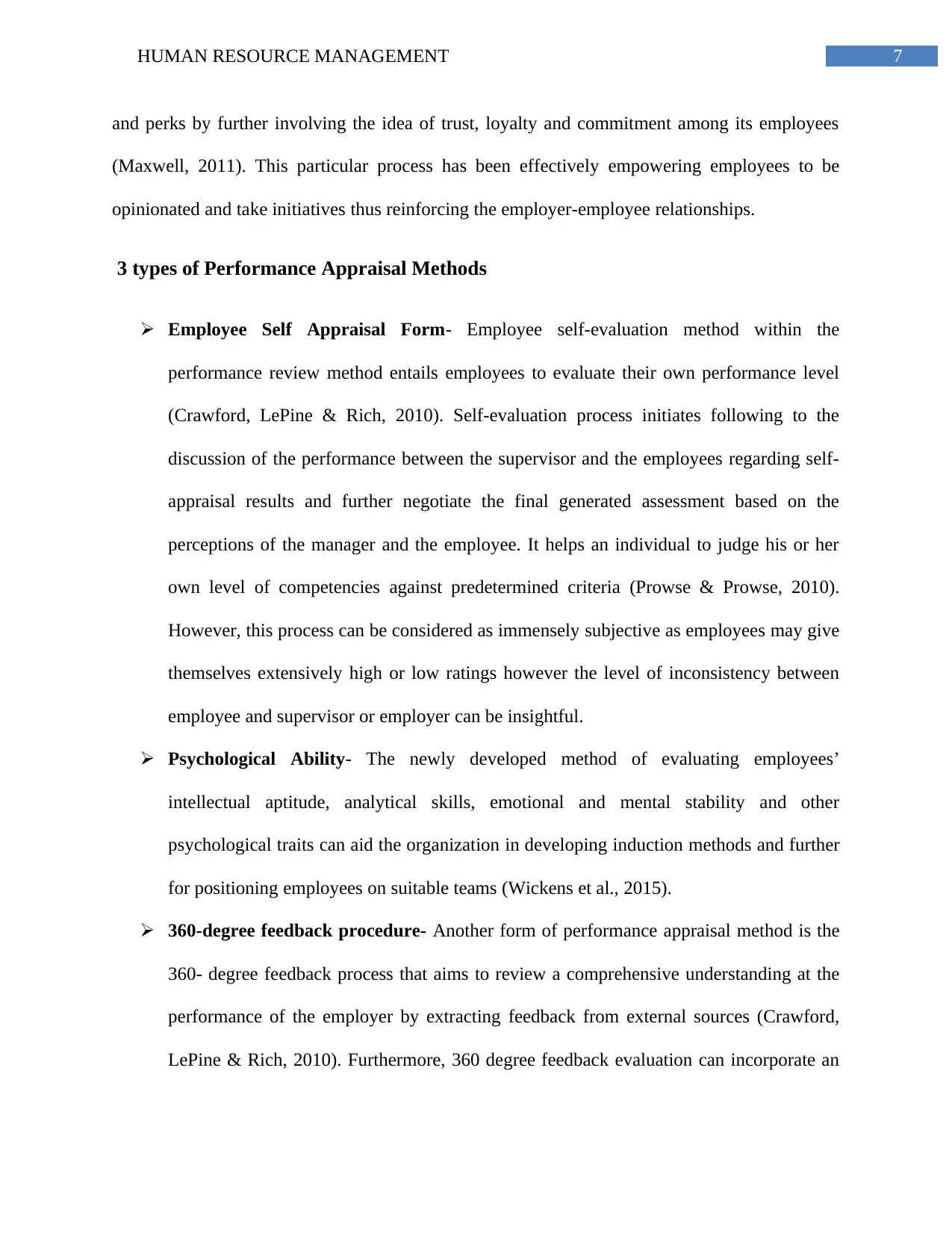
7HUMAN RESOURCE MANAGEMENT
and perks by further involving the idea of trust, loyalty and commitment among its employees
(Maxwell, 2011). This particular process has been effectively empowering employees to be
opinionated and take initiatives thus reinforcing the employer-employee relationships.
3 types of Performance Appraisal Methods
Employee Self Appraisal Form- Employee self-evaluation method within the
performance review method entails employees to evaluate their own performance level
(Crawford, LePine & Rich, 2010). Self-evaluation process initiates following to the
discussion of the performance between the supervisor and the employees regarding self-
appraisal results and further negotiate the final generated assessment based on the
perceptions of the manager and the employee. It helps an individual to judge his or her
own level of competencies against predetermined criteria (Prowse & Prowse, 2010).
However, this process can be considered as immensely subjective as employees may give
themselves extensively high or low ratings however the level of inconsistency between
employee and supervisor or employer can be insightful.
Psychological Ability- The newly developed method of evaluating employees’
intellectual aptitude, analytical skills, emotional and mental stability and other
psychological traits can aid the organization in developing induction methods and further
for positioning employees on suitable teams (Wickens et al., 2015).
360-degree feedback procedure- Another form of performance appraisal method is the
360- degree feedback process that aims to review a comprehensive understanding at the
performance of the employer by extracting feedback from external sources (Crawford,
LePine & Rich, 2010). Furthermore, 360 degree feedback evaluation can incorporate an
and perks by further involving the idea of trust, loyalty and commitment among its employees
(Maxwell, 2011). This particular process has been effectively empowering employees to be
opinionated and take initiatives thus reinforcing the employer-employee relationships.
3 types of Performance Appraisal Methods
Employee Self Appraisal Form- Employee self-evaluation method within the
performance review method entails employees to evaluate their own performance level
(Crawford, LePine & Rich, 2010). Self-evaluation process initiates following to the
discussion of the performance between the supervisor and the employees regarding self-
appraisal results and further negotiate the final generated assessment based on the
perceptions of the manager and the employee. It helps an individual to judge his or her
own level of competencies against predetermined criteria (Prowse & Prowse, 2010).
However, this process can be considered as immensely subjective as employees may give
themselves extensively high or low ratings however the level of inconsistency between
employee and supervisor or employer can be insightful.
Psychological Ability- The newly developed method of evaluating employees’
intellectual aptitude, analytical skills, emotional and mental stability and other
psychological traits can aid the organization in developing induction methods and further
for positioning employees on suitable teams (Wickens et al., 2015).
360-degree feedback procedure- Another form of performance appraisal method is the
360- degree feedback process that aims to review a comprehensive understanding at the
performance of the employer by extracting feedback from external sources (Crawford,
LePine & Rich, 2010). Furthermore, 360 degree feedback evaluation can incorporate an
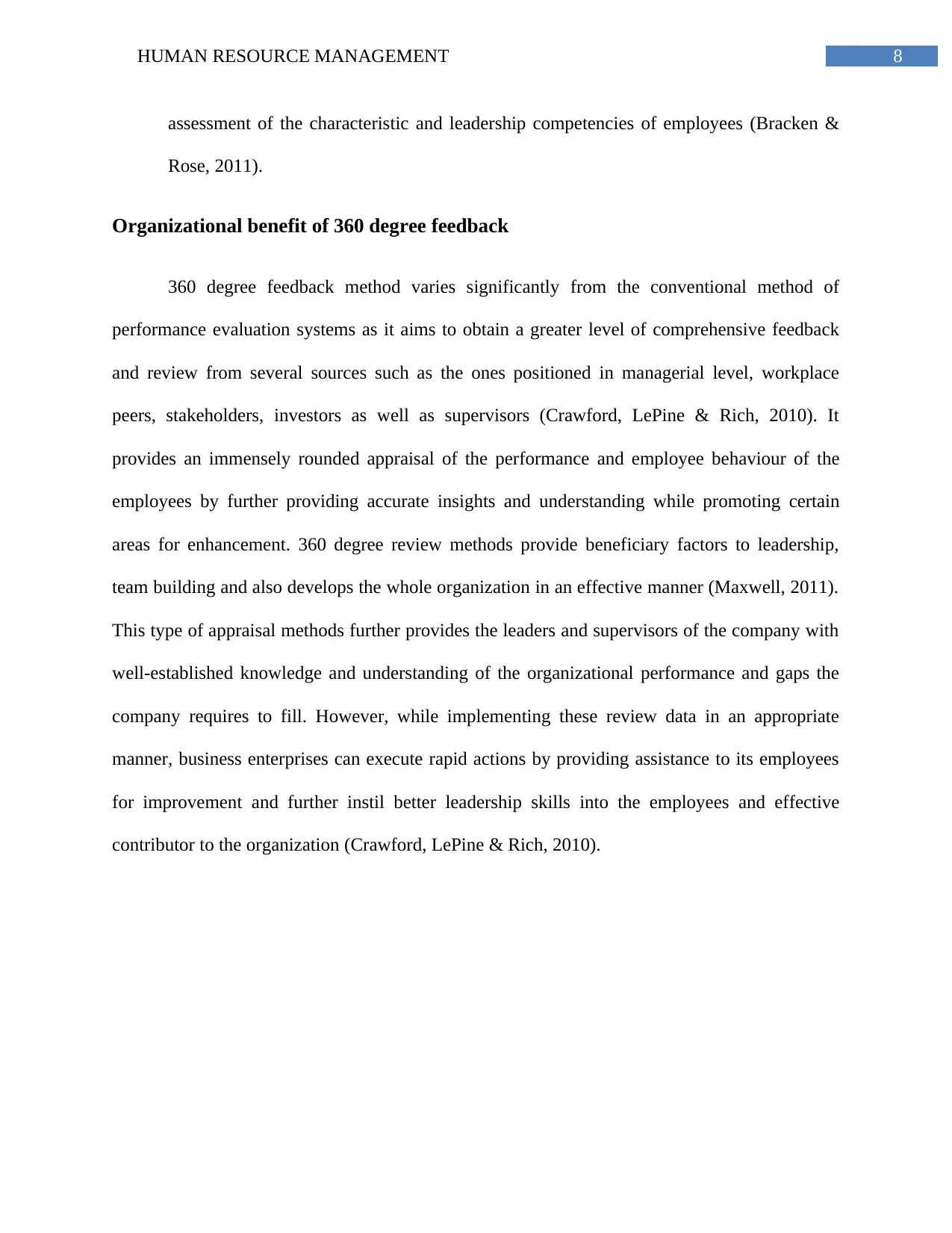
8HUMAN RESOURCE MANAGEMENT
assessment of the characteristic and leadership competencies of employees (Bracken &
Rose, 2011).
Organizational benefit of 360 degree feedback
360 degree feedback method varies significantly from the conventional method of
performance evaluation systems as it aims to obtain a greater level of comprehensive feedback
and review from several sources such as the ones positioned in managerial level, workplace
peers, stakeholders, investors as well as supervisors (Crawford, LePine & Rich, 2010). It
provides an immensely rounded appraisal of the performance and employee behaviour of the
employees by further providing accurate insights and understanding while promoting certain
areas for enhancement. 360 degree review methods provide beneficiary factors to leadership,
team building and also develops the whole organization in an effective manner (Maxwell, 2011).
This type of appraisal methods further provides the leaders and supervisors of the company with
well-established knowledge and understanding of the organizational performance and gaps the
company requires to fill. However, while implementing these review data in an appropriate
manner, business enterprises can execute rapid actions by providing assistance to its employees
for improvement and further instil better leadership skills into the employees and effective
contributor to the organization (Crawford, LePine & Rich, 2010).
assessment of the characteristic and leadership competencies of employees (Bracken &
Rose, 2011).
Organizational benefit of 360 degree feedback
360 degree feedback method varies significantly from the conventional method of
performance evaluation systems as it aims to obtain a greater level of comprehensive feedback
and review from several sources such as the ones positioned in managerial level, workplace
peers, stakeholders, investors as well as supervisors (Crawford, LePine & Rich, 2010). It
provides an immensely rounded appraisal of the performance and employee behaviour of the
employees by further providing accurate insights and understanding while promoting certain
areas for enhancement. 360 degree review methods provide beneficiary factors to leadership,
team building and also develops the whole organization in an effective manner (Maxwell, 2011).
This type of appraisal methods further provides the leaders and supervisors of the company with
well-established knowledge and understanding of the organizational performance and gaps the
company requires to fill. However, while implementing these review data in an appropriate
manner, business enterprises can execute rapid actions by providing assistance to its employees
for improvement and further instil better leadership skills into the employees and effective
contributor to the organization (Crawford, LePine & Rich, 2010).
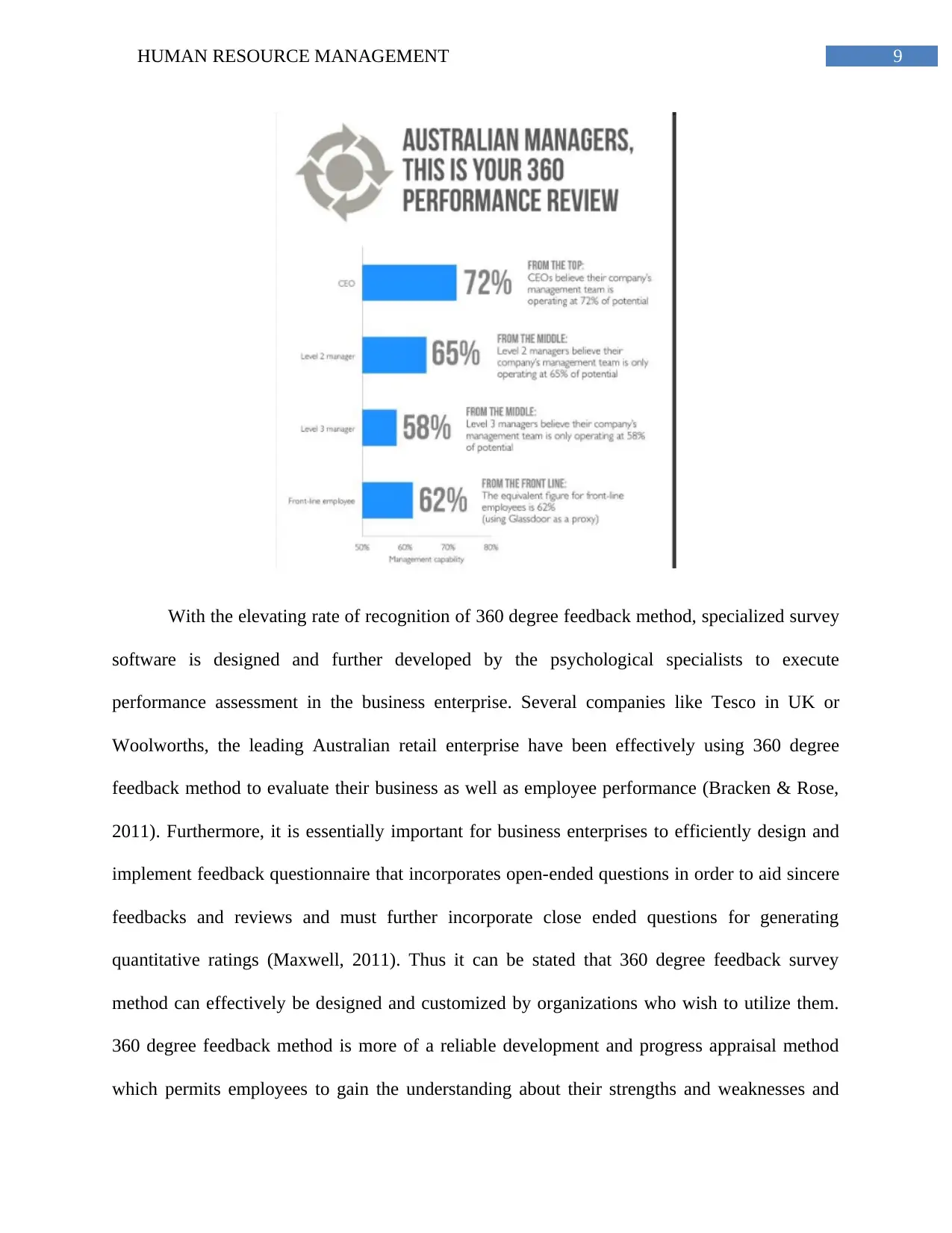
9HUMAN RESOURCE MANAGEMENT
With the elevating rate of recognition of 360 degree feedback method, specialized survey
software is designed and further developed by the psychological specialists to execute
performance assessment in the business enterprise. Several companies like Tesco in UK or
Woolworths, the leading Australian retail enterprise have been effectively using 360 degree
feedback method to evaluate their business as well as employee performance (Bracken & Rose,
2011). Furthermore, it is essentially important for business enterprises to efficiently design and
implement feedback questionnaire that incorporates open-ended questions in order to aid sincere
feedbacks and reviews and must further incorporate close ended questions for generating
quantitative ratings (Maxwell, 2011). Thus it can be stated that 360 degree feedback survey
method can effectively be designed and customized by organizations who wish to utilize them.
360 degree feedback method is more of a reliable development and progress appraisal method
which permits employees to gain the understanding about their strengths and weaknesses and
With the elevating rate of recognition of 360 degree feedback method, specialized survey
software is designed and further developed by the psychological specialists to execute
performance assessment in the business enterprise. Several companies like Tesco in UK or
Woolworths, the leading Australian retail enterprise have been effectively using 360 degree
feedback method to evaluate their business as well as employee performance (Bracken & Rose,
2011). Furthermore, it is essentially important for business enterprises to efficiently design and
implement feedback questionnaire that incorporates open-ended questions in order to aid sincere
feedbacks and reviews and must further incorporate close ended questions for generating
quantitative ratings (Maxwell, 2011). Thus it can be stated that 360 degree feedback survey
method can effectively be designed and customized by organizations who wish to utilize them.
360 degree feedback method is more of a reliable development and progress appraisal method
which permits employees to gain the understanding about their strengths and weaknesses and
Secure Best Marks with AI Grader
Need help grading? Try our AI Grader for instant feedback on your assignments.
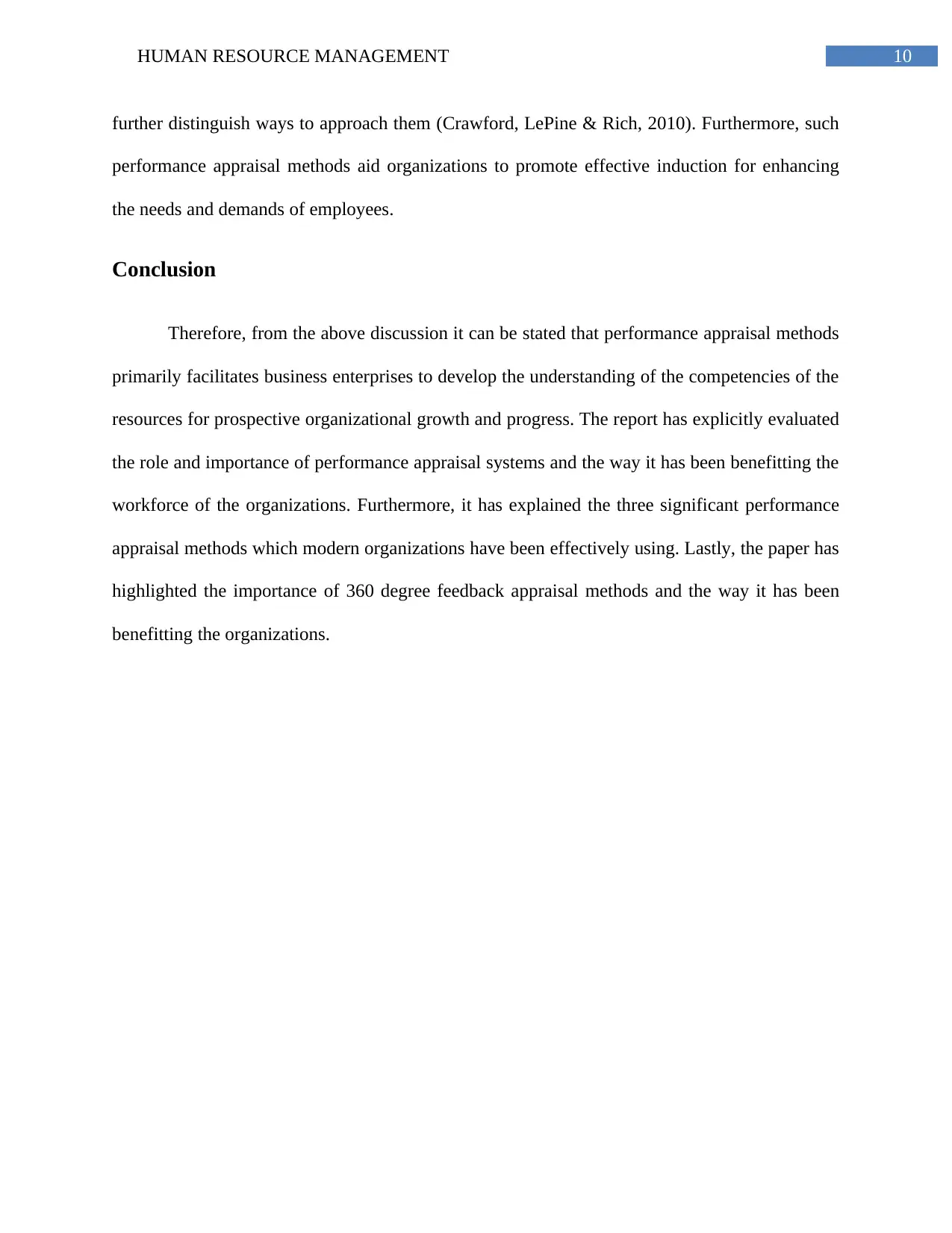
10HUMAN RESOURCE MANAGEMENT
further distinguish ways to approach them (Crawford, LePine & Rich, 2010). Furthermore, such
performance appraisal methods aid organizations to promote effective induction for enhancing
the needs and demands of employees.
Conclusion
Therefore, from the above discussion it can be stated that performance appraisal methods
primarily facilitates business enterprises to develop the understanding of the competencies of the
resources for prospective organizational growth and progress. The report has explicitly evaluated
the role and importance of performance appraisal systems and the way it has been benefitting the
workforce of the organizations. Furthermore, it has explained the three significant performance
appraisal methods which modern organizations have been effectively using. Lastly, the paper has
highlighted the importance of 360 degree feedback appraisal methods and the way it has been
benefitting the organizations.
further distinguish ways to approach them (Crawford, LePine & Rich, 2010). Furthermore, such
performance appraisal methods aid organizations to promote effective induction for enhancing
the needs and demands of employees.
Conclusion
Therefore, from the above discussion it can be stated that performance appraisal methods
primarily facilitates business enterprises to develop the understanding of the competencies of the
resources for prospective organizational growth and progress. The report has explicitly evaluated
the role and importance of performance appraisal systems and the way it has been benefitting the
workforce of the organizations. Furthermore, it has explained the three significant performance
appraisal methods which modern organizations have been effectively using. Lastly, the paper has
highlighted the importance of 360 degree feedback appraisal methods and the way it has been
benefitting the organizations.
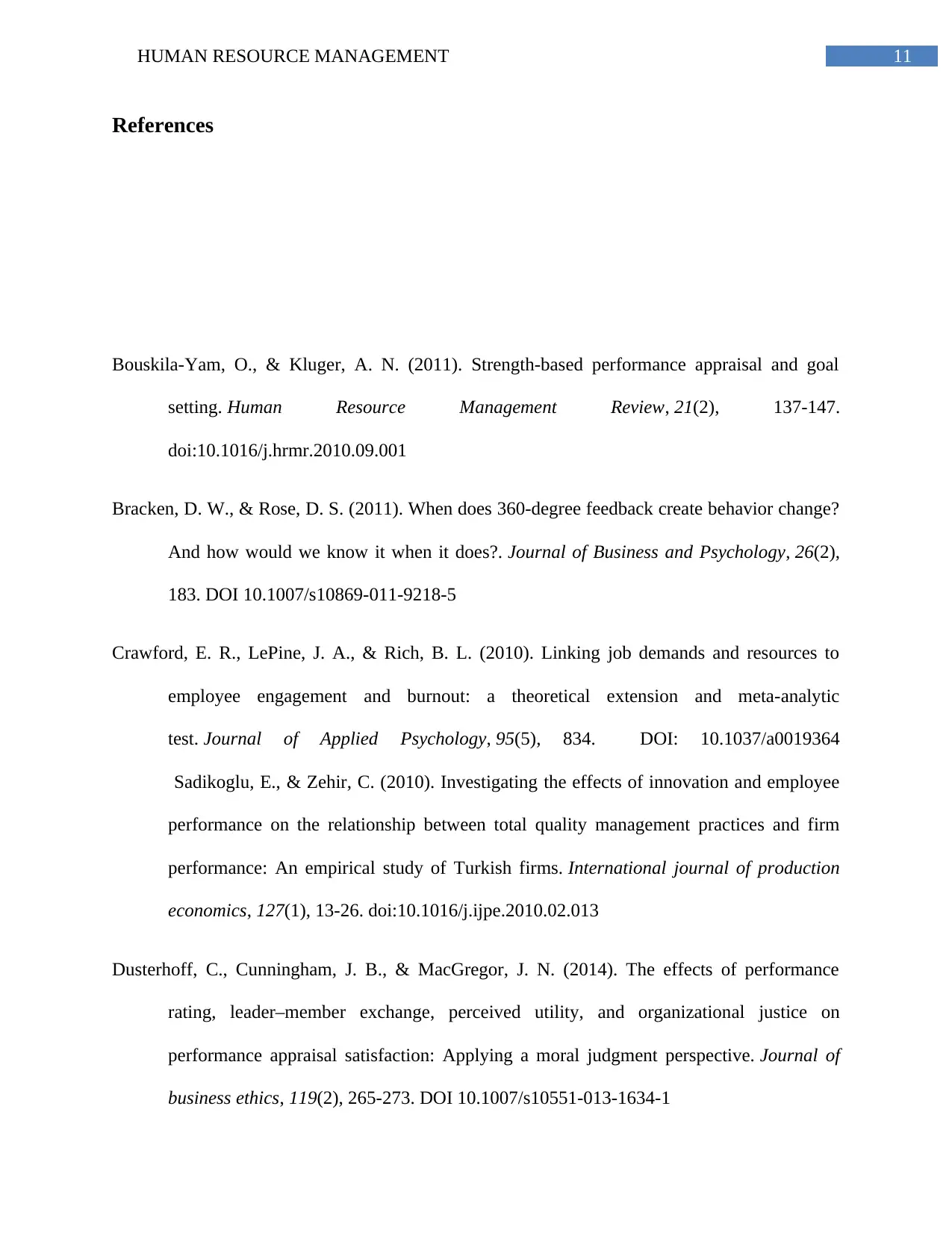
11HUMAN RESOURCE MANAGEMENT
References
Bouskila-Yam, O., & Kluger, A. N. (2011). Strength-based performance appraisal and goal
setting. Human Resource Management Review, 21(2), 137-147.
doi:10.1016/j.hrmr.2010.09.001
Bracken, D. W., & Rose, D. S. (2011). When does 360-degree feedback create behavior change?
And how would we know it when it does?. Journal of Business and Psychology, 26(2),
183. DOI 10.1007/s10869-011-9218-5
Crawford, E. R., LePine, J. A., & Rich, B. L. (2010). Linking job demands and resources to
employee engagement and burnout: a theoretical extension and meta-analytic
test. Journal of Applied Psychology, 95(5), 834. DOI: 10.1037/a0019364
Sadikoglu, E., & Zehir, C. (2010). Investigating the effects of innovation and employee
performance on the relationship between total quality management practices and firm
performance: An empirical study of Turkish firms. International journal of production
economics, 127(1), 13-26. doi:10.1016/j.ijpe.2010.02.013
Dusterhoff, C., Cunningham, J. B., & MacGregor, J. N. (2014). The effects of performance
rating, leader–member exchange, perceived utility, and organizational justice on
performance appraisal satisfaction: Applying a moral judgment perspective. Journal of
business ethics, 119(2), 265-273. DOI 10.1007/s10551-013-1634-1
References
Bouskila-Yam, O., & Kluger, A. N. (2011). Strength-based performance appraisal and goal
setting. Human Resource Management Review, 21(2), 137-147.
doi:10.1016/j.hrmr.2010.09.001
Bracken, D. W., & Rose, D. S. (2011). When does 360-degree feedback create behavior change?
And how would we know it when it does?. Journal of Business and Psychology, 26(2),
183. DOI 10.1007/s10869-011-9218-5
Crawford, E. R., LePine, J. A., & Rich, B. L. (2010). Linking job demands and resources to
employee engagement and burnout: a theoretical extension and meta-analytic
test. Journal of Applied Psychology, 95(5), 834. DOI: 10.1037/a0019364
Sadikoglu, E., & Zehir, C. (2010). Investigating the effects of innovation and employee
performance on the relationship between total quality management practices and firm
performance: An empirical study of Turkish firms. International journal of production
economics, 127(1), 13-26. doi:10.1016/j.ijpe.2010.02.013
Dusterhoff, C., Cunningham, J. B., & MacGregor, J. N. (2014). The effects of performance
rating, leader–member exchange, perceived utility, and organizational justice on
performance appraisal satisfaction: Applying a moral judgment perspective. Journal of
business ethics, 119(2), 265-273. DOI 10.1007/s10551-013-1634-1
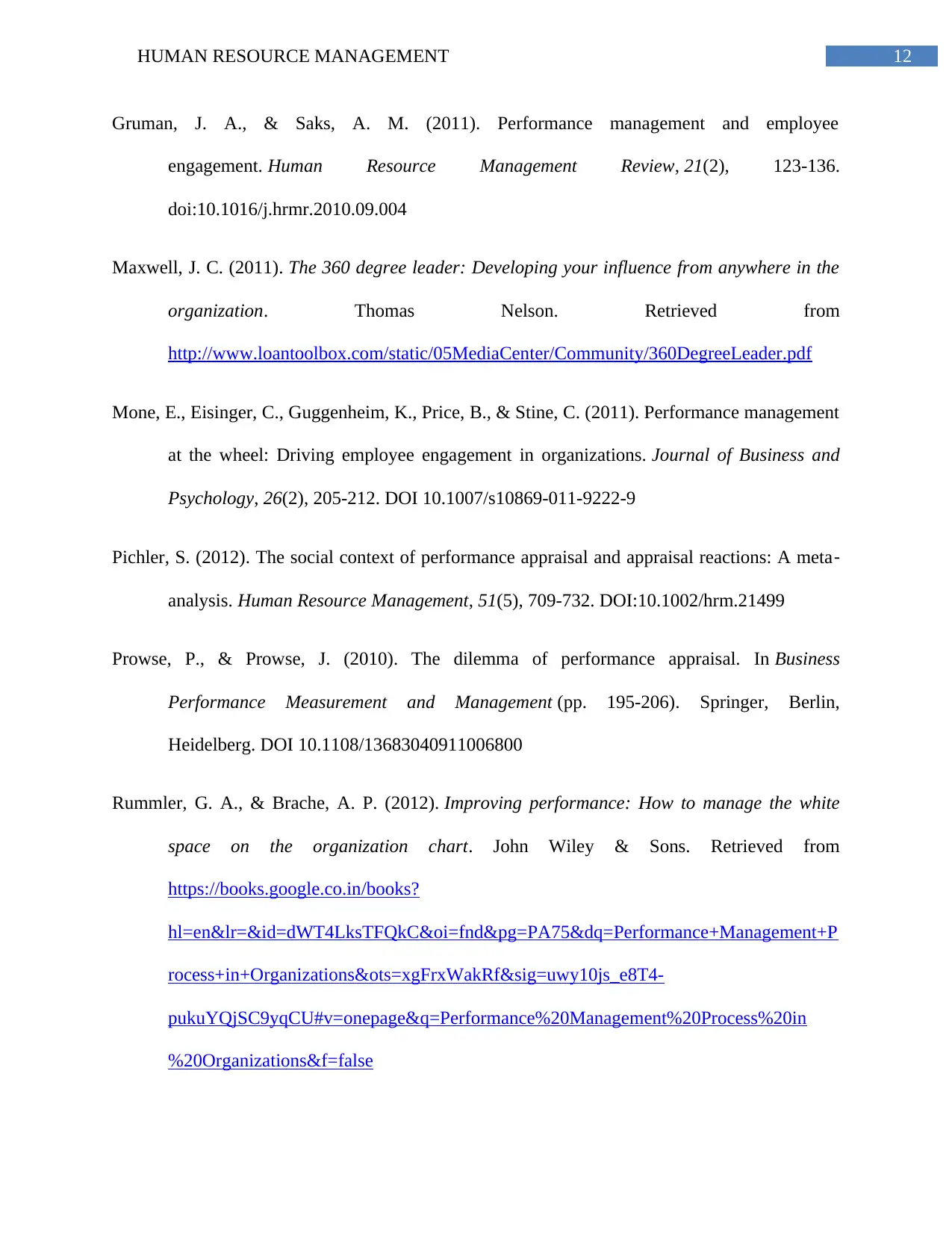
12HUMAN RESOURCE MANAGEMENT
Gruman, J. A., & Saks, A. M. (2011). Performance management and employee
engagement. Human Resource Management Review, 21(2), 123-136.
doi:10.1016/j.hrmr.2010.09.004
Maxwell, J. C. (2011). The 360 degree leader: Developing your influence from anywhere in the
organization. Thomas Nelson. Retrieved from
http://www.loantoolbox.com/static/05MediaCenter/Community/360DegreeLeader.pdf
Mone, E., Eisinger, C., Guggenheim, K., Price, B., & Stine, C. (2011). Performance management
at the wheel: Driving employee engagement in organizations. Journal of Business and
Psychology, 26(2), 205-212. DOI 10.1007/s10869-011-9222-9
Pichler, S. (2012). The social context of performance appraisal and appraisal reactions: A meta‐
analysis. Human Resource Management, 51(5), 709-732. DOI:10.1002/hrm.21499
Prowse, P., & Prowse, J. (2010). The dilemma of performance appraisal. In Business
Performance Measurement and Management (pp. 195-206). Springer, Berlin,
Heidelberg. DOI 10.1108/13683040911006800
Rummler, G. A., & Brache, A. P. (2012). Improving performance: How to manage the white
space on the organization chart. John Wiley & Sons. Retrieved from
https://books.google.co.in/books?
hl=en&lr=&id=dWT4LksTFQkC&oi=fnd&pg=PA75&dq=Performance+Management+P
rocess+in+Organizations&ots=xgFrxWakRf&sig=uwy10js_e8T4-
pukuYQjSC9yqCU#v=onepage&q=Performance%20Management%20Process%20in
%20Organizations&f=false
Gruman, J. A., & Saks, A. M. (2011). Performance management and employee
engagement. Human Resource Management Review, 21(2), 123-136.
doi:10.1016/j.hrmr.2010.09.004
Maxwell, J. C. (2011). The 360 degree leader: Developing your influence from anywhere in the
organization. Thomas Nelson. Retrieved from
http://www.loantoolbox.com/static/05MediaCenter/Community/360DegreeLeader.pdf
Mone, E., Eisinger, C., Guggenheim, K., Price, B., & Stine, C. (2011). Performance management
at the wheel: Driving employee engagement in organizations. Journal of Business and
Psychology, 26(2), 205-212. DOI 10.1007/s10869-011-9222-9
Pichler, S. (2012). The social context of performance appraisal and appraisal reactions: A meta‐
analysis. Human Resource Management, 51(5), 709-732. DOI:10.1002/hrm.21499
Prowse, P., & Prowse, J. (2010). The dilemma of performance appraisal. In Business
Performance Measurement and Management (pp. 195-206). Springer, Berlin,
Heidelberg. DOI 10.1108/13683040911006800
Rummler, G. A., & Brache, A. P. (2012). Improving performance: How to manage the white
space on the organization chart. John Wiley & Sons. Retrieved from
https://books.google.co.in/books?
hl=en&lr=&id=dWT4LksTFQkC&oi=fnd&pg=PA75&dq=Performance+Management+P
rocess+in+Organizations&ots=xgFrxWakRf&sig=uwy10js_e8T4-
pukuYQjSC9yqCU#v=onepage&q=Performance%20Management%20Process%20in
%20Organizations&f=false
Paraphrase This Document
Need a fresh take? Get an instant paraphrase of this document with our AI Paraphraser
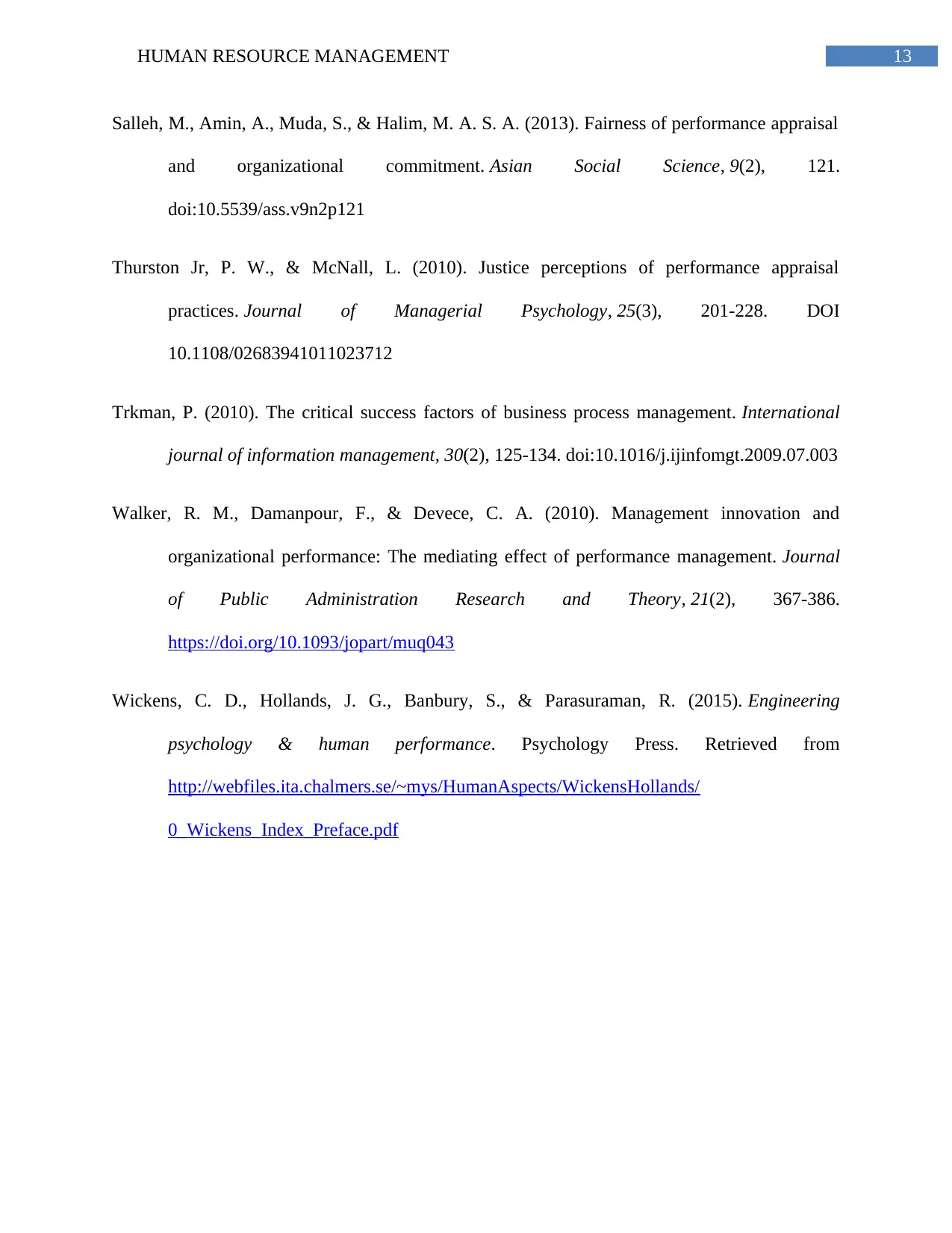
13HUMAN RESOURCE MANAGEMENT
Salleh, M., Amin, A., Muda, S., & Halim, M. A. S. A. (2013). Fairness of performance appraisal
and organizational commitment. Asian Social Science, 9(2), 121.
doi:10.5539/ass.v9n2p121
Thurston Jr, P. W., & McNall, L. (2010). Justice perceptions of performance appraisal
practices. Journal of Managerial Psychology, 25(3), 201-228. DOI
10.1108/02683941011023712
Trkman, P. (2010). The critical success factors of business process management. International
journal of information management, 30(2), 125-134. doi:10.1016/j.ijinfomgt.2009.07.003
Walker, R. M., Damanpour, F., & Devece, C. A. (2010). Management innovation and
organizational performance: The mediating effect of performance management. Journal
of Public Administration Research and Theory, 21(2), 367-386.
https://doi.org/10.1093/jopart/muq043
Wickens, C. D., Hollands, J. G., Banbury, S., & Parasuraman, R. (2015). Engineering
psychology & human performance. Psychology Press. Retrieved from
http://webfiles.ita.chalmers.se/~mys/HumanAspects/WickensHollands/
0_Wickens_Index_Preface.pdf
Salleh, M., Amin, A., Muda, S., & Halim, M. A. S. A. (2013). Fairness of performance appraisal
and organizational commitment. Asian Social Science, 9(2), 121.
doi:10.5539/ass.v9n2p121
Thurston Jr, P. W., & McNall, L. (2010). Justice perceptions of performance appraisal
practices. Journal of Managerial Psychology, 25(3), 201-228. DOI
10.1108/02683941011023712
Trkman, P. (2010). The critical success factors of business process management. International
journal of information management, 30(2), 125-134. doi:10.1016/j.ijinfomgt.2009.07.003
Walker, R. M., Damanpour, F., & Devece, C. A. (2010). Management innovation and
organizational performance: The mediating effect of performance management. Journal
of Public Administration Research and Theory, 21(2), 367-386.
https://doi.org/10.1093/jopart/muq043
Wickens, C. D., Hollands, J. G., Banbury, S., & Parasuraman, R. (2015). Engineering
psychology & human performance. Psychology Press. Retrieved from
http://webfiles.ita.chalmers.se/~mys/HumanAspects/WickensHollands/
0_Wickens_Index_Preface.pdf
1 out of 14
Related Documents
Your All-in-One AI-Powered Toolkit for Academic Success.
+13062052269
info@desklib.com
Available 24*7 on WhatsApp / Email
![[object Object]](/_next/static/media/star-bottom.7253800d.svg)
Unlock your academic potential
© 2024 | Zucol Services PVT LTD | All rights reserved.





